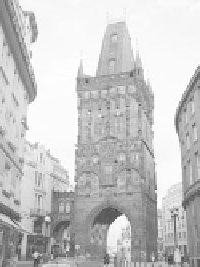Travel Reference
In-Depth Information
Prague: Pre-1989
It's hard to imagine the gray and bleak Prague of the com-
munist era. Before 1989, the city was a wistful jumble of pos-
sibility. Cobbled lanes were shadowed by decrepit, crusty
buildings. Timbers—strung across the lanes like laundry
lines—held crumbling buildings apart. Consumer goods were
plain and uniform, stacked like Legos on thin shelves in shops
where customers waited in line for a tin of pineapples or a
bottle of ersatz Coke. The Charles Bridge and its statues were
black with soot, and there was no commerce, except for a few
shady characters trying to change money. Hotels had two
price schedules: one for people of the Warsaw Pact nations,
and another (6-8 times more expensive) for capitalists. This
made the run-down, Soviet-style hotels as expensive as fine
Western ones. At the train station, frightened but desperate
folks would meet arriving foreigners and offer to rent them a
room in their flat, hoping to earn enough hard Western cash
to buy batteries or Levi's at one of the hard-currency stores.
sentiment. Across the street, the classical fixer-upper from 1815
was the customs house, which has recently been turned into a giant
stage for Broadway-style musicals. The stark national bank building
(Česká Národní Banka) is textbook Functionalism from the 1930s.
Farther away, across the square, former Neo-Romanesque barracks
have been transformed into central Prague's biggest shopping mall
and underground parking lot.
Powder Tower:
The big, black
Powder Tower (not wor th tou ring
inside) was the Gothic gate of the
town wall, built to house the cit y's
g unpowder. The decoration on the
tower, portraying Czech kings, is the
best 15th-century sculpture in town. If
you go through the tower, you'll reach
Celetná street, which leads past a few
sights to the Old Town Square (see
page 52).
Národní Třída: Communist Prague
From Můstek at the bottom of Wenceslas Square, you can head
west on Národní Třída (in the opposite direction from Na Příkopě
and the Art Nouveau sights) for an interesting stroll through urban
Prague to the National Theatre and the Vltava River. But first,
consider dropping into the Museum of Communism, a few steps
down Na Příkopě (on the right).




















